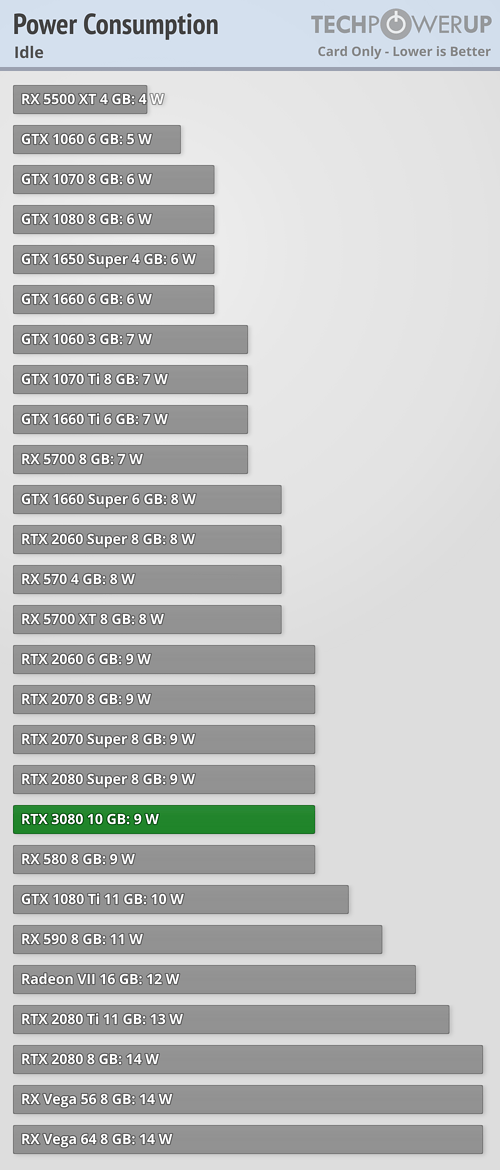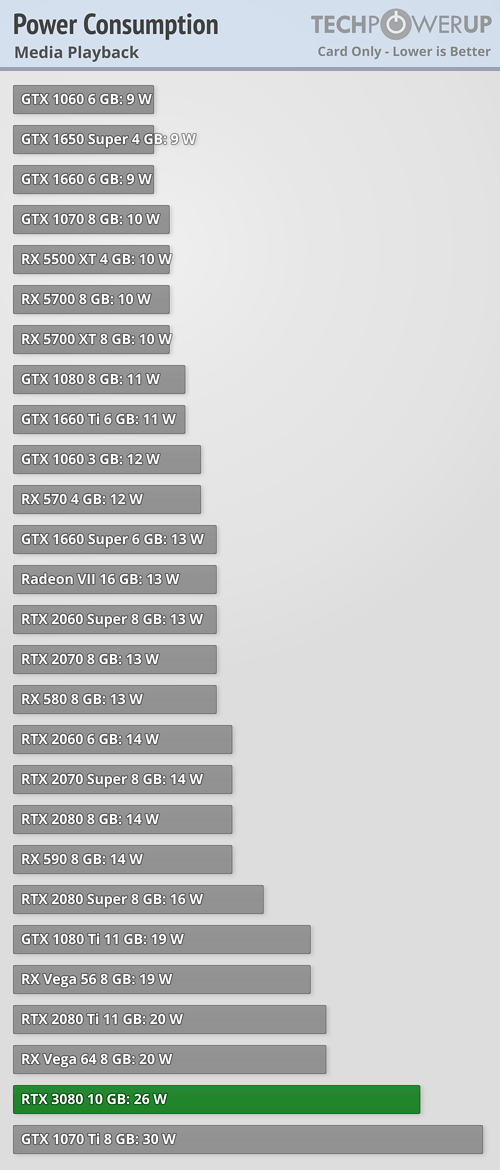 355
355
NVIDIA GeForce RTX 3080 Founders Edition Review - Must-Have for 4K Gamers
Clock Speeds & Power Limit »Power Consumption
Idle power consumption of RTX 3080 Ampere is a little bit better than Turing 2080/2080 Ti. While it's only a few watts, the 4 W savings are definitely appreciated, especially for people who work on their gaming PC all day.
Multi-monitor power consumption matches Turing almost exactly. The new media decode engine, while more powerful, also draws a bit more power. A 6 W increase over the 2080 Ti isn't a huge deal, but still surprising.
Gaming power consumption is at the top of our charts, but the performance on tap with the RTX 3080 is more than impressive. Around 300 W is only 10% more power draw than the RTX 2080 Ti—while achieving +25% gaming performance. When considering performance per watt, the improvement is "nice", but certainly not groundbreaking. I guess the next move to TSMC 7 nanometer or below could achieve that.
Furmark maximum power reaches 370 W, which is right at the limit of the card's 12-pin + PCIe slot power input capability.
Minimum recommended PSU: 700 W






Apr 14th, 2025 07:34 EDT
change timezone
Latest GPU Drivers
New Forum Posts
- Kingston FURY 2x32GB DDR5 5600 MHz CL36 runs at @4800 CL40 (10)
- Share your Speedometer 2.0 benchmark here (122)
- High-end build in the 2025 mad world situation (21)
- 7800X3D and 5070 Ti / 9070 XT Build (10)
- Regarding fan noise (22)
- Advice on GPU upgrade (22)
- What's your latest tech purchase? (23544)
- Lian Li O11 Dynamic XL ROG. (16)
- SK hynix A-Die (Overclocking thread) only for RYZEN AM5 users (32)
- RX 9000 series GPU Owners Club (314)
Popular Reviews
- TerraMaster F8 SSD Plus Review - Compact and quiet
- ASUS GeForce RTX 5080 TUF OC Review
- Thermaltake TR100 Review
- The Last Of Us Part 2 Performance Benchmark Review - 30 GPUs Compared
- Zotac GeForce RTX 5070 Ti Amp Extreme Review
- Sapphire Radeon RX 9070 XT Pulse Review
- Sapphire Radeon RX 9070 XT Nitro+ Review - Beating NVIDIA
- Upcoming Hardware Launches 2025 (Updated Apr 2025)
- MSI MAG CORELIQUID A15 360 Review
- AMD Ryzen 7 9800X3D Review - The Best Gaming Processor
Controversial News Posts
- NVIDIA GeForce RTX 5060 Ti 16 GB SKU Likely Launching at $499, According to Supply Chain Leak (181)
- MSI Doesn't Plan Radeon RX 9000 Series GPUs, Skips AMD RDNA 4 Generation Entirely (146)
- NVIDIA Sends MSRP Numbers to Partners: GeForce RTX 5060 Ti 8 GB at $379, RTX 5060 Ti 16 GB at $429 (124)
- Nintendo Confirms That Switch 2 Joy-Cons Will Not Utilize Hall Effect Stick Technology (105)
- Over 200,000 Sold Radeon RX 9070 and RX 9070 XT GPUs? AMD Says No Number was Given (100)
- Nintendo Switch 2 Launches June 5 at $449.99 with New Hardware and Games (99)
- NVIDIA Pushes GeForce RTX 5060 Ti Launch to Mid-April, RTX 5060 to May (77)
- NVIDIA PhysX and Flow Made Fully Open-Source (77)